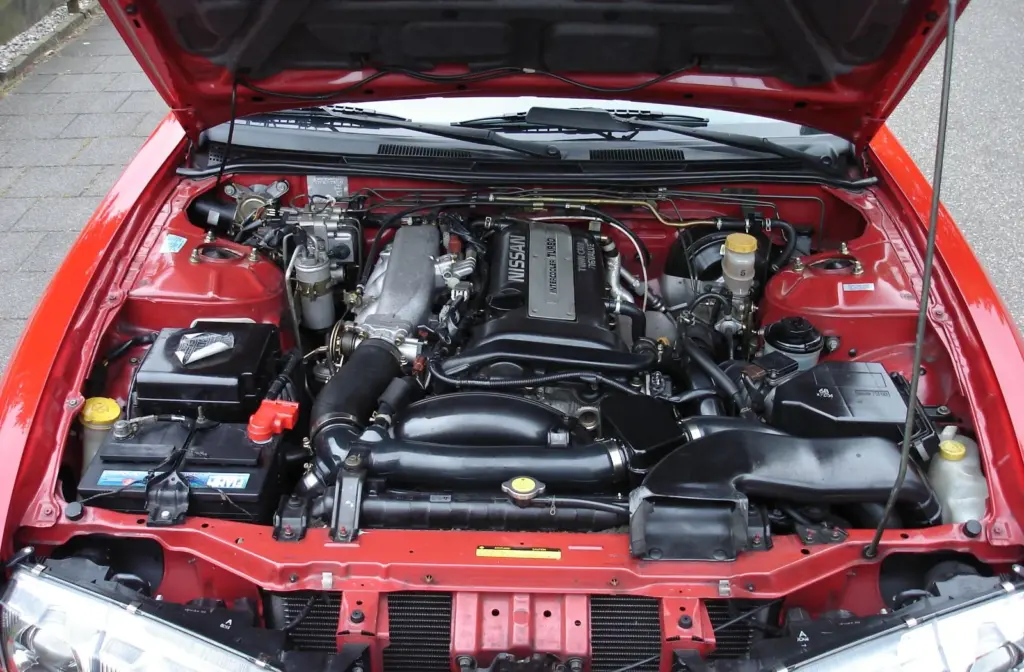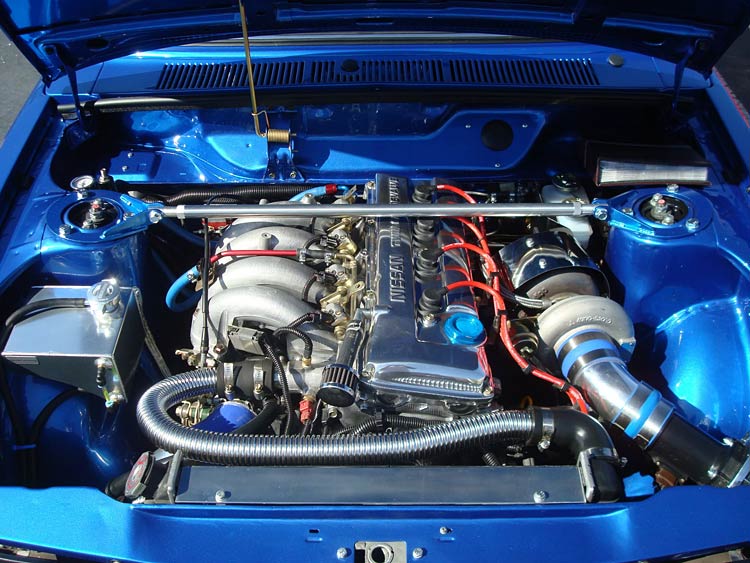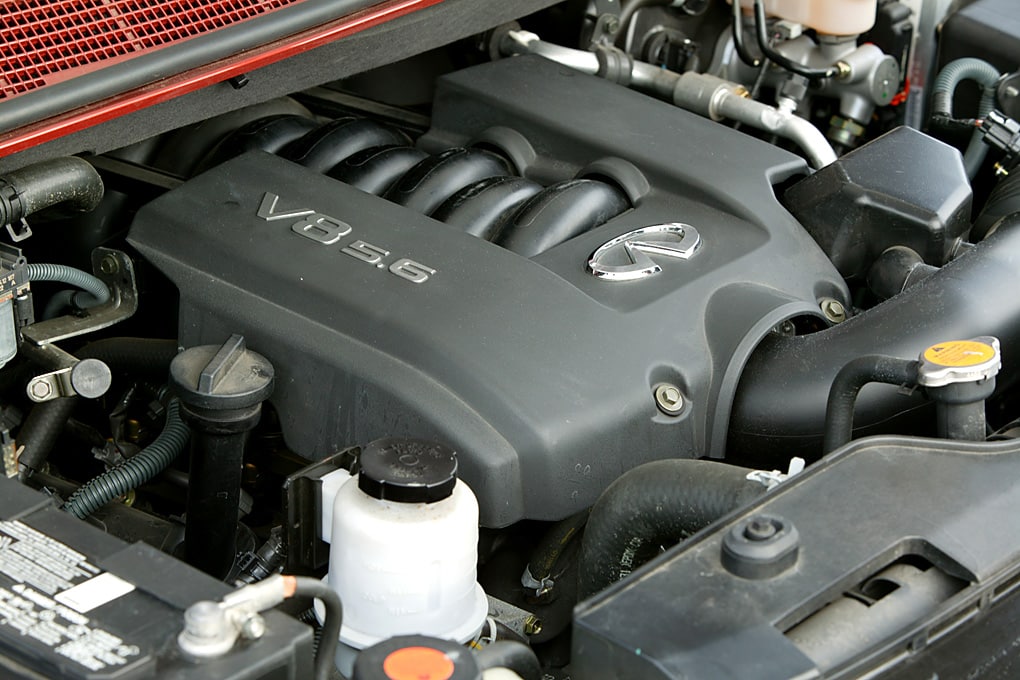VG30DETT is a 3.0-liter V6 motor. Being for sale in the United States between 1990 and 1996, it was applied for Nissan 300ZX Twin Turbo for the American market and Nissan Fairlady Z in Japan (till 2000).
Though the 300ZX automobile could also be equipped with a VG30DE motor, VG30DETT became the most widespread choice thanks to twin turbochargers.
Its name can tell a lot about this motor as Nissan opts for the engine’s name utilizing an expository code of letters and numbers. For instance, VG is the name of the motor line.
The manufacture of VG motors was launched in 1983 and lasted till 2004. They were preceded by motors of L range, released between 1967 and 1983. The debut of the VG30DETT motor was produced in the United States in 1990. It was manufactured for 6 years, till 1996, though in 1994, the Nissan VQ motor, which is still manufactured, replaced it.
Furthermore, while VG signifies the motor series, the other symbols are also important.
Thus, number 30 indicates the engine’s 3.0-liter capacity; D implies that the valve mechanism features dual overhead camshafts; E stands for the electronic fuel injection while TT denotes the motor’s twin turbochargers. Besides, there are also VG30DET motors, where one T means that the engine is supplied with only one turbocharger.
VG30DETT gained great popularity due to its outstanding output. It reached 300 hp and a torque of 283 lb/ft.
In 1990, Z-automobiles by the Nissan brand turned into the best-selling sports vehicles available for sale. More than 1 million cars were purchased that year.
Besides, at the 1990 Super Bowl, Nissan even presented an ad in which 300ZX won the drag race, competing with motorcycles, airplanes, and LeMans race automobiles. However, that commercial was never shown again.
VG30DETT Specs
The breakdown of the engine code is as follows:
- VG – Engine Family
- 30 – 3.0 Liter Displacement
- D – DOHC (Dual Overhead Camshafts)
- E – Multi-Point Fuel Injection
- E – Twin-Turbocharged
| Engine code | VG30DETT |
| Layout | Four-stroke, V6 |
| Fuel type | Gasoline (petrol) |
| Production | 1987-2000 |
| Displacement | 3.0L, 2,960 cc (180.62 cu in) |
| Fuel system | Multi Point Fuel Injection |
| Power adder | Twin T22/TB02 turbochargers |
| Power output | 280 PS (206 KW; 276 HP) at 6,400 rpm 284 PS (209 KW; 280 HP) at 6,400 rpm 330 PS (242 KW; 325 HP) at 6,800 rpm |
| Torque output | 382 Nm (39.0 kg·m; 281.9 ft·lb) at 3,200 rpm 384 Nm (39.2 kg·m; 283.4 ft·lb) at 3,200 rpm 388 Nm (39.6 kg·m; 286.3 ft·lb) at 3,600 rpm |
| Firing order | 1-2-3-4-5-6 |
| Dimensions (L x W x H): | – |
| Cylinder block alloy | Cast-iron | |
| Compression ratio | 8.5:1 | |
| Cylinder bore | 87.0 mm (3.43 in) | |
| Piston stroke | 83.0 mm (3.27 in) | |
| Number of piston rings (compression/oil): | 2 / 1 | |
| Number of main bearings: | 4 | |
| Cylinder inner diameter (standard): | 87.000-87.010 mm (3.4252-3.4256 in) | |
| Piston skirt diameter (standard): | 86.975-86.985 mm (3.4242-3.4246 in) | |
| Piston pin outer diameter: | 21.993-22.001 mm (0.8657-0.8662 in) | |
| Piston ring side clearance: | Top | 0.040-0.073 mm (0.0016-0.0029 in) |
| Second | 0.030-0.063 mm (0.0012-0.0025 in) | |
| Oil | 0.015-0.185 mm (0.0006-0.0073 in) | |
| Piston ring end gap: | Top | 0.21-0.40 mm (0.0083-0.0157 in) |
| Second | 0.50-0.76 mm (0.0197-0.0299 in) | |
| Oil | 0.20-0.76 mm (0.0079-0.0299 in) | |
| Connecting rod small end diameter: | 22.000-22.012 mm (0.8661-0.8666 in) | |
| Connecting rod center distance: | 154.1-154.2 mm (6.067-6.071 in) | |
| Crankshaft main journal diameter: | 62.975 mm (2.4763 in) | |
| Crankpin diameter: | 49.974 mm (1.9675 in) | |
| Crankshaft center distance: | 41.47-41.53 mm (1.6327-1.6350 in) | |
| Cylinder head | ||
| Blockhead alloy | Aluminum | |
| Valve Arrangement: | DOHC, belt drive | |
| Head surface flatness | Less than 0.05 mm (0.002 in) | |
| Valves: | 24 (4 valves per cylinder) | |
| Intake valve timing | 248° | |
| Exhaust valve timing: | 248° | |
| Valve head diameter: | INTAKE | 34.0-34.2 mm (1.339-1.346 in) |
| EXHAUST | 29.5-29.7 mm (1.161-1.169 in) | |
| Valve length: | INTAKE | 103.1-103.3 mm (4.06-4.067 in) |
| EXHAUST | 103.6-103.8 mm (4.079-4087 in) | |
| Valve stem diameter: | INTAKE | 6.965-6.980 mm (0.2743-0.2748 in) |
| EXHAUST | 7.945-7.960 mm (0.3128-0.3134 in) | |
| Valve spring free length: | OUTER | 43.1 mm (1.697 in) |
| INNER | 43.1 mm (1.697 in) | |
| Camshaft cam height: | INTAKE | 40.405-40.595 mm (1.5907-1.5982 in) |
| EXHAUST | 40.405-40.595 mm (1.5907-1.5982 in) | |
What Cars Have A VG30DETT?
- 1987 Nissan MID4-II Concept (non-production)
- 1989–2000 Nissan Fairlady Z Twin Turbo (Japan)
- 1990–1996 Nissan 300ZX Twin Turbo (US)
Peculiarities Of VG30DETT Efficiency
Being built on the framework of non-turbo VG30DE, this motor was subjected to various modifications with the purpose of getting great performance results.
Having bore and stroke of 87×83 mm, it kept compression index of 8.5.
Power of 300 hp and a torque of 283 lb/ft was achieved thanks to the upgrading of twin Garrett T22/TB02 turbochargers and dual intercoolers. The capacity was 3.0 liters (2,960cc or 180 cu in).
To see how fantastic that engine was for 1990, you are free to compare it with the one of 1990 Ford Mustang, which was a 5.0-liter motor with an output of 225 hp and a torque of 300 ft/lb.
Having less capacity but producing more power, 300ZX was a real success. And it was the main merit of twin turbochargers.
Despite having many more astonishing peculiarities, VG30DETT became the final Nissan motor, comprising 4 valves per cylinder, double overhead camshafts plus a turbocharger. Additionally, RB20DET motor had the identical configuration.
Head And Block Construction
VG30DETT featured an iron block with aluminum heads, which made the motor rather robust to cope with the increased power, produced by twin turbochargers. Moreover, owners of these engines state that they can be very durable if proper maintenance is provided.
The valve mechanism contained double overhead camshafts, variable valve timing plus Nissan’s Valve Timing Control System. Variable valve timing deals with improving performance and raising fuel efficiency.
As VG30DETT is a 6V motor with double overhead camshafts, de facto, it features four camshafts (a quad-cam). In total, there are 24 valves with 4 valves per cylinder.
VG30DETT Engine Problems And Reliability
VG30DETT is often referred to as a bulletproof engine. Usually, troubles arise because of the old thing crashing and corroded connectors. Additionally, first versions of motors had troubles with fuel injectors. But oil leakage or heating problems aren’t common.
In the vehicles, released in 1990-1991, the brake master cylinder may start leaking after a 40,000-50,000 miles run. The replacement will cost you about $200. The latest parts are upgraded and so, they have a longer lifespan. If a car you are going to buy has any of these malfunctions, tell the distributor that you will pay less and spend the saved sum on the details’ renovation.
Automobiles with turbocharging, released before 1/90, plus naturally aspirated vehicles, manufactured before 7/90, may face troubles with defective valves. Valves can unscrew themselves from the head, leading to the rough idle and compression reduction. In order to prevent this problem, it’s advisable to inspect the motor number. Turbo vehicles with motor numbers below 619550 and naturally aspirated vehicles with numbers below 777599 often face this malfunction. Additionally, take a look at the data tags attached to the doorpost at the driver’s side and under the hood. They contain information about the date of manufacture along with serial numbers.
| Compression pressure | |
| Standard | 12.0 kg/m2 (171 psi) / 300 rpm |
| Minimum | 9.0 kg/m2 (128 psi) / 300 rpm |
| Compression differential limit between cylinders | 1.0 kg/m2 (15 psi) / 300 rpm |
| Oil system | |
| Oil consumption, L/1000 km (qt. per mile) | up to 0.5 (1 qt. per 1200 miles) |
| Recommended engine oil | 5W-30, 10W-30, 10W-40, 20W-40, 20W-50 |
| Oil type API | API SG |
| Engine Oil Capacity (Refill capacity) | With filter change 3.4 l (3-5/8 Us. qt., 3 Imp. qt) Without filter change 3.0 l (3-1/8 Us. qt., 2-5/8 Imp. qt.) |
| Oil change interval, km (miles) | Every 6,000 (3,750) |
| Oil pressure | Idle speed (78 kPA, 0.8 kg/cm3, 11 psi) 3,000 rpm (353-451 kPA, 3.6-4.6 kg/cm3, 51-65 psi) |
| Ignition system | |
| Spark plug | NGK Platinum-tipped type: PFR5B-11B |
| Spark plug tightening torque | 20-29 Nm; 2.0-3.0 kg·m; 14-22 ft·lb |
To Sum It Up
Remaining rather a widespread motor, VG30DETT is a strong and enduring engine, able to achieve 300 hp with almost no troubles.
Having less capacity and greater output than its rival, 5.0-liter 1990 Ford Mustang, the 300ZX automobile became one of the most popular sports cars of that time. However, the motor was in stock only at the American market and was sold only till 1996. So, there is a pretty limited amount of these engines, which still function.
Usually, they are kept by collectors or drivers, obsessed with high-performance cars. So, it can be pretty hard to acquire VG30DETT.




